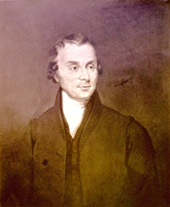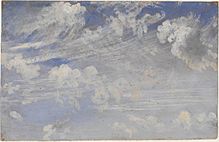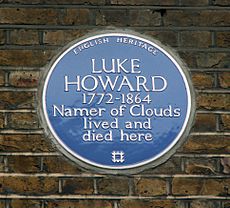Luke Howard facts for kids
Quick facts for kids
Luke Howard
|
|
|---|---|
 |
|
| Born | 28 November 1772 |
| Died | (aged 91) London, United Kingdom
|
| Nationality | British |
| Citizenship | United Kingdom |
| Known for | Naming the Sky |
| Scientific career | |
| Fields | Meteorology, Chemistry, Pharmaceuticals |
Luke Howard (born November 28, 1772 – died March 21, 1864) was a British scientist. He was a chemist who made medicines and also studied the weather as a hobby. His most important contribution to science was creating a way to name and classify clouds. He shared this idea in 1802. Because of his work, people often call him "The Godfather of Clouds" or "the namer of the clouds." He is also known as the "father of meteorology," which is the study of weather.
Contents
Who Was Luke Howard?
Early Life and Family
Luke Howard was born in London on November 28, 1772. His father, Robert Howard, made tin-plate, and his mother was Elizabeth Leatham. Luke went to a Quaker school in Burford, Oxfordshire.
In 1796, Luke Howard married Mariabella Eliot. They had two sons, Robert and John Eliot Howard. These sons later took over their father's business. Their daughter Elizabeth married John Hodgkin, who was a lawyer.
Religious Beliefs
Luke Howard was a member of the Quakers. However, he left the group in 1825 after a disagreement. He fully resigned in 1836 due to a bigger split within the Quakers. In 1837, he was baptized into another Christian group called the Plymouth Brethren.
Howard passed away on March 21, 1864, in Tottenham, London. He is buried at the Quaker Meeting House in Winchmore Hill.
Luke Howard's Career
Becoming a Pharmacist
Luke Howard trained to become a pharmacist, someone who prepares and sells medicines. He learned his skills in Stockport, Cheshire. After that, he worked at a drug store in London before opening his own pharmacy.
In 1798, he started a business with another Quaker, William Allen. Their company, Allen and Howard, made medicines. Howard managed their factory in Plaistow, east of London. The partnership ended in 1807, and Howard moved his factory to Stratford, East London. This factory grew into a very successful company called Howards and Sons by 1856.
Recognition for His Work
In 1821, Luke Howard was chosen as a Fellow of the Royal Society. This is a very respected group of scientists. He lived in Ackworth, Yorkshire, from 1824 to 1852.
Howard's Scientific Discoveries
The Father of Meteorology
Luke Howard is often called "the father of meteorology." This is because he carefully recorded weather in London from 1801 to 1841. His writings greatly changed how people studied weather.
He was also interested in plants. He wrote a paper about pollen that was published in 1802. But he told the famous writer Goethe that his true passion was studying the weather.
How Howard Classified Clouds
When he was in his late twenties, Luke Howard wrote an important essay called Essay on the Modification of Clouds. It was published in 1803. Howard's system for naming clouds was similar to the Linnaean classification system. This system was used to classify living things like plants and animals.
Howard gave names to the three main types of clouds:
- Cumulus: These are puffy, white clouds.
- Stratus: These are flat, gray clouds that cover the sky.
- Cirrus: These are thin, wispy clouds high in the sky.
He also named mixed types, like cirrostratus and cirrocumulus. This helped describe how clouds change from one form to another. By using Latin names, his system could be understood by scientists everywhere.
In his 1803 essay, Howard included detailed drawings of clouds. These drawings came from his own notes and sketches. He believed that clouds formed and disappeared based on the laws of physics. He even had a term for cloud formation: "nubification," though it never became popular.
Howard knew some things about clouds that were correct. For example, he and his friend, chemist John Dalton, believed clouds were made of water particles. They also thought that the particles fell slowly because of air resistance and evaporated below the cloud base. However, Howard also thought electricity played too big a role in cloud formation.
Other Cloud Systems
Luke Howard was not the first person to try classifying clouds. A French biologist named Jean-Baptiste Lamarck also suggested a system in the same year. Lamarck used French terms, and his essay had no pictures. His system was not as popular as Howard's. Howard's system became famous because he used universal Latin names and applied a clear classification method.
Later Weather Studies
Besides his work on clouds, Howard wrote many other papers about weather. He was also a pioneer in studying city climates. He published The Climate of London in 1818–20. This long book had 700 pages of daily weather observations, including wind, pressure, temperature, and rainfall.
In this book, Howard was the first to notice the urban heat island effect. He showed that London was warmer at night than the countryside around it. He also linked this effect to the concentration of smog, which he called 'city fog'.
In 1837, Luke Howard published the first textbook on meteorology, called Seven Lectures in Meteorology. In this book, he again shared his cloud classification system. He stressed that clouds are important for weather study and follow "fixed Laws."
Luke Howard's Lasting Impact
Influence on Science
Howard's cloud classification system was later used and made even more popular by other meteorologists. They noted that Howard, being a Quaker, preferred names not linked to ancient myths.
Influence on Art
Howard's cloud system also had a big impact on art. His original essay was translated into German and French in 1815. This allowed the German writer Goethe to read it. Goethe was fascinated by Howard's system and wrote poems praising him. He even tried to get a German painter to create cloud studies based on Howard's ideas.
Howard's work is also thought to have inspired Shelley's poem "The Cloud." It also influenced the paintings of John Constable, who created many studies of skies. The writer and artist John Ruskin also used Howard's cloud classification in his art criticisms.
Memorials and Recognition
Luke Howard is honored with an English Heritage blue plaque at 7 Bruce Grove, Tottenham. This was the house where he died. The plaque simply calls him "Namer of Clouds." Howard also helped develop a religious meeting house in Tottenham with his son, John Eliot Howard. This is now the Brook Street Chapel.
Howard lived at The River House in Stratford while his factory was in Plaistow. His daily trips between his home and factory helped him observe and categorize clouds.
In 2018, the Tottenham Hotspur FC football club, located near his old home, named viewing areas in their new stadium after his cloud names. These areas, with great views of the field and London, are called 'Stratus East' and 'Stratus West'. This recognizes Howard's important work in classifying clouds.
See also
 In Spanish: Luke Howard para niños
In Spanish: Luke Howard para niños





